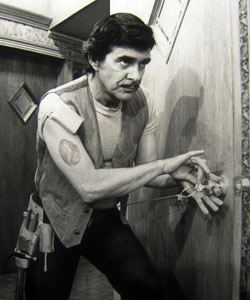Kiplinger Q&A: Pat Harrington Jr.
Pat Harrington Jr. (a.k.a. Schneider from the '70s hit sitcom One Day at a Time and veteran Kiplinger's subscriber) shares valuable lessons about personal finance.

Actor, writer, comedian and Kiplinger’s subscriber Pat Harrington Jr., died this week at the age of 86. Many may remember him as Schneider from the 1970s sitcom One Day at a Time but he was also known for appearing in countless sitcoms and motion pictures, as well as the voice of several notable cartoon characters. Pat started his acting and writing career in television during its golden age in the 1950s, gaining popularity as a sketch comic for late night talk show innovator Steve Allen and appearing as a regular for Jack Paar on his Tonight Show.
A man who took charge of his personal finances, as he did his career, Pat spoke to us back in 2008 about the mistakes he made when he first started investing his money and the lessons he learned.
When did you first start investing?

Sign up for Kiplinger’s Free E-Newsletters
Profit and prosper with the best of expert advice on investing, taxes, retirement, personal finance and more - straight to your e-mail.
Profit and prosper with the best of expert advice - straight to your e-mail.
When I was working on One Day at a Time, which aired from 1975 to 1984. In the last three years of that show I was making an enormous income. So I got together with a big investing firm and put my money in stocks.
Did your investments do well?
No, that firm really failed me. The managers put my money where they wanted it. I lost about 30% to 40% of my stake. I also had a business manager who went south on me by making bad buys in real estate.
How did you survive all that?
I just worked harder. Luckily, I received a lot of money from residuals because I had a large body of work dating from the late 1950s. Then I sat down and began examining financial newsletters. After trying two or three, I settled on Navellier in 2002.
With good results?
I have more than doubled my money. When I started with Navellier, nothing made sense. I was completely in the firm's hands the first couple of years. Now, I own 50 stocks in a TD Ameritrade account, and I do all the purchasing and selling. In 2007, I earned about 15%.
How do you keep up with 50 stocks?
I'm on the computer every day. The first thing I do in the morning is take a look at what's happening. I may sell some shares to raise a little cash.

Any other sources of income?
I have three pensions (Screen Actors Guild, American Federation of Television and Radio Artists, and Actors' Equity) and Social Security benefits. When I get out of bed on January 1, I know I have x number of dollars coming in for the year. And that's a terrific feeling.
What lessons have you learned over the years? Saving is important because you have to be able to handle emergencies, and you don't want to start breaking down your investments to pull money out. When it comes to investing, hold on to your money until you're just a bit more sure than unsure. Then you can start. But that has to be a totally informed process. You have to do your homework.
Get Kiplinger Today newsletter — free
Profit and prosper with the best of Kiplinger's advice on investing, taxes, retirement, personal finance and much more. Delivered daily. Enter your email in the box and click Sign Me Up.

-
 The Best Places for LGBTQ People to Retire Abroad
The Best Places for LGBTQ People to Retire AbroadLGBTQ people can safely retire abroad, but they must know a country’s laws and level of support — going beyond the usual retirement considerations.
By Drew Limsky Published
-
 Financial Planning's Paradox: Balancing Riches and True Wealth
Financial Planning's Paradox: Balancing Riches and True WealthWhile enough money is important for financial security, it does not guarantee fulfillment. How can retirees and financial advisers keep their eye on the ball?
By Richard P. Himmer, PhD Published
-
 Best Banks for High-Net-Worth Clients
Best Banks for High-Net-Worth Clientswealth management These banks welcome customers who keep high balances in deposit and investment accounts, showering them with fee breaks and access to financial-planning services.
By Lisa Gerstner Last updated
-
 Stock Market Holidays in 2025: NYSE, NASDAQ and Wall Street Holidays
Stock Market Holidays in 2025: NYSE, NASDAQ and Wall Street HolidaysMarkets When are the stock market holidays? Here, we look at which days the NYSE, Nasdaq and bond markets are off in 2025.
By Kyle Woodley Last updated
-
 Stock Market Trading Hours: What Time Is the Stock Market Open Today?
Stock Market Trading Hours: What Time Is the Stock Market Open Today?Markets When does the market open? While the stock market does have regular hours, trading doesn't necessarily stop when the major exchanges close.
By Michael DeSenne Last updated
-
 Bogleheads Stay the Course
Bogleheads Stay the CourseBears and market volatility don’t scare these die-hard Vanguard investors.
By Kim Clark Published
-
 The Current I-Bond Rate Until May Is Mildly Attractive. Here's Why.
The Current I-Bond Rate Until May Is Mildly Attractive. Here's Why.Investing for Income The current I-bond rate is active until November 2024 and presents an attractive value, if not as attractive as in the recent past.
By David Muhlbaum Last updated
-
 What Are I-Bonds? Inflation Made Them Popular. What Now?
What Are I-Bonds? Inflation Made Them Popular. What Now?savings bonds Inflation has made Series I savings bonds, known as I-bonds, enormously popular with risk-averse investors. So how do they work?
By Lisa Gerstner Last updated
-
 This New Sustainable ETF’s Pitch? Give Back Profits.
This New Sustainable ETF’s Pitch? Give Back Profits.investing Newday’s ETF partners with UNICEF and other groups.
By Ellen Kennedy Published
-
 As the Market Falls, New Retirees Need a Plan
As the Market Falls, New Retirees Need a Planretirement If you’re in the early stages of your retirement, you’re likely in a rough spot watching your portfolio shrink. We have some strategies to make the best of things.
By David Rodeck Published